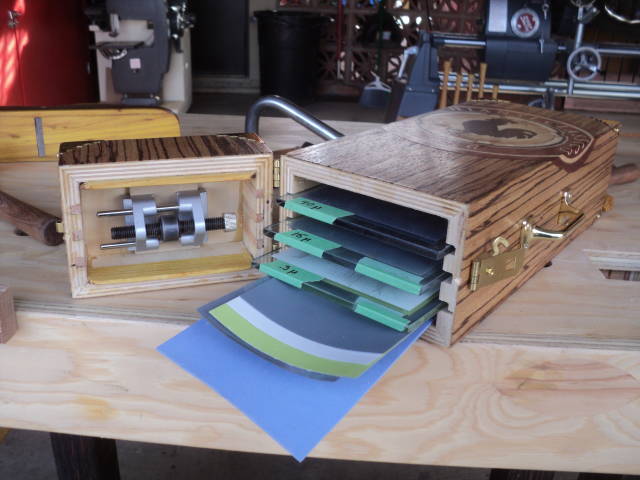10 Replies
I live in Houston TX. we have a very humid climate. My shop is a two door garage un-insulated.
My tools would go dull over night. I bought a tormex 3 and after that keep all my sharp tools in the ac.
My wife does not like this but she wants the house finished.
Tor and Odin are the greatest of gods.
I’m struggling with my sharpening. I use the ‘scary-sharp’ (sandpaper) method, and get to a 2,000 grit (and a near-mirror finish); however, my plane is an old Stanley (#4) and I need to get to probably 8,000 grit. I’ve given-up on water stones (keeping them flat eludes me); the Tormek got me about as far as I am now with the scary-sharp. My next adventure is into stropping and diamond paste. As you can tell, I’m grasping at straws.
MJCD
The strop works with the green compound. When I saw my cabinet-maker friend sharpen some British carving tools I bought from him, I was hooked. He sharpens saws and I’ve come to learn that really sharp tools are a dream to work with. I’ve learned two very important things this year, how to sharpen chisels and plane blades and how to sharpen saws. I used the Norton stones I got for the first time tonight and I was really pleased. They are a little messy but c’mon it’s only water. I got a flattening stone and used the pencil method to get them flat before I sharpened the first chisel. The kit came with a DVD but I did the flattening different than the guy on the DVD. I held them up and used both hands to rub the flattening stone and the working stone together. I also used water to lubricate things. After I did my chisels perfectly, I had black marks from the steel on all of the stones. I went to the sink in the kitchen and used the flattening stone again until the marks were all gone. Now, when I sharpen next, the stones will be ready. Using the flattening stone at the sink was a good idea and that’s how I will maintain the stones from now on. Do the flattening under running water. The black marks went away while the stones get flattened. The 8000 stone gave the perfect polish, shiny, and scary-sharp.
David L. Whitehurst
I’ve been using the “scary sharp” since long before the term hit news print. It remains a great way to get a premium edge. Once you have a few sheets of super fine grit paper, you’re off and running.
If you like mirror polish, consider picking up a jar of McGuires Mag Polish. A quick buff on the drill press and my knife edges look great.
When buffing, remember to hold the blade so the edge will be thrown away from you, if grabbed. If it were a buffer, you’d stay on the low end, so it didn’t throw it at your face.
As to the green paste some mentioned, it might be chromium oxide, which those sharpening straight razors like.
For those looking for a good base to mount sandpaper on, drop by a granite counter place and ask if you can have a piece from their trash. They have to throw away tons of granite that would make a great surface. In a pinch, you can also buy a granite tile from a big box.
While there will always be those who claim you have to free hand to qualify as competent, they are welcome to their tiny little world(s). The rest of us can use jigs and things to insure we don’t keep changing the angle of our edge. As was said in a certain well known wood working magazine, a guy made a comment about people using a hone guide to sharpen blades, but shut up and left when he was asked if he ever made a woodworking jig?
Most of us don’t have to sharpen the same tool over and over again. I have about one hundred edges in my shop. No two are the same, so relying on muscle memory is a fool’s errand. At least for me and everyone I know.
I took the plunge and bough an Edge Pro. Before, I hatcheted my way through potatoes. Now, both my wife and I are amazed. At first, we thought we’d gotten old potatoes, because the knives seemed to all but fall through them. Now, we know it’s the effect of having a real edge.
So, if your way wasn’t working, buy or build a jig and see what you think about using a tool with a true, sharp edge.
Thanks for the post, David
Oh, and the Edge Pro uses the wet stones. Though I still have [coarse] diamond plates for getting to the angle I want quickly, I’m sold on water stones.
I had some aluminum around and an old belt. I glued the belt to the aluminum and apply McGuires mag polish to one and chromium oxide to another. I can either run the belt over the blade or visa versa.
I recently discovered 3M micro abrasive film. Tools For Working Wood sells a sample pack of five 8 1/2 × 11 sheets for $13.95. The grits are 40, 15, 5, 1, and .3 microns. (1 micron = about 8000 grit) I cut the sheets in half and mount them (they are PSA) on 6″ × 12″glass plates. They stay nice and clean and store easily in a small box. I couldn’t be happier with the speed and quality of the process.
I for one am done with the mess and expense of stones.

The early bird gets the worm but its the second mouse that gets the cheese.
I used wet stone at the beginning and quickly ruined both side. Since I did not how to flatten the stone back that was the end of it.
I moved to the sandpaper method and that worked pretty good. I passed the “arm shave” test successfully.
Then I saw the worksharp 3000 and bought one. I used it few times. It works fine but
In all honesty I would done just fine with the sandpaper.
Now when my chisel gets dull I reach for a 400 grit and take a few lap and it’s useable again.
For what I do with it, this plenty fine.
Abbas, Castro Valley, CA
I’ve only had my water stones for about a week now. But, I learned quickly that the stones get black marks from the tools, so I lap the flattening stone and the good stone together under running water. When the black marks are gone, I consider the stone to be flat. I’m very pleased with them. I use a strop with chromium-oxide about every 15 minutes when I’m chiseling. I just glanced my finger with the chisel yesterday and it was bleeding. When they say “scary sharp” they mean it. The tool worked beautifully. I did 30 lap joints yesterday by hand and I believe that I would be done before my competitor got his router table set up.
David L. Whitehurst
Paul Sellers "":http://paulsellers.com has some good videos about sharpening. I use a combination of DMT diamond stones (coarse, extra fine, extra extra fine) and Norton combination waterstone (4000/8000grit) with very good results. I get a mirror polish and a razor sharp edge.
I don’t use guides very often, but will when necessary. To me, the use of guides is purely a personal preference.
Artisan Woodworks of Texas- www.awwtx.com
I’m with you on the guides. I like Paul Sellers because he’s real. He’s not pimping tools so he just shares how he does it. I like that.
I imagine the diamond stones cut fast and that’s probably nice. I don’t like to stop when I’m in the moment. So if you have to sharpen before you finish, it should be quick and then back to work.
David L. Whitehurst













